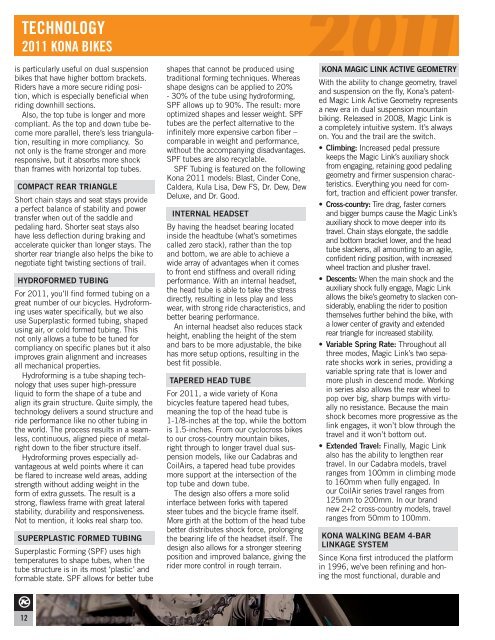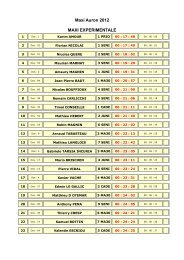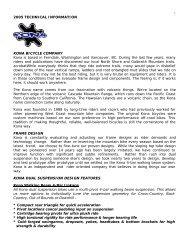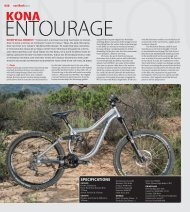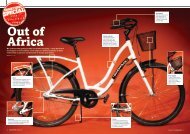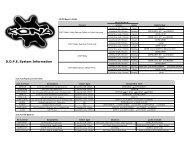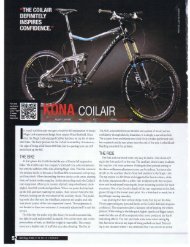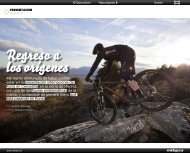specifications geometry - Kona
specifications geometry - Kona
specifications geometry - Kona
Create successful ePaper yourself
Turn your PDF publications into a flip-book with our unique Google optimized e-Paper software.
TECHNOLOGY<br />
2011 KONA BIKES<br />
is particularly useful on dual suspension<br />
bikes that have higher bottom brackets.<br />
Riders have a more secure riding position,<br />
which is especially beneficial when<br />
riding downhill sections.<br />
Also, the top tube is longer and more<br />
compliant. As the top and down tube become<br />
more parallel, there’s less triangulation,<br />
resulting in more compliancy. So<br />
not only is the frame stronger and more<br />
responsive, but it absorbs more shock<br />
than frames with horizontal top tubes.<br />
COMPACT REAR TRIANGLE<br />
Short chain stays and seat stays provide<br />
a perfect balance of stability and power<br />
transfer when out of the saddle and<br />
pedaling hard. Shorter seat stays also<br />
have less deflection during braking and<br />
accelerate quicker than longer stays. The<br />
shorter rear triangle also helps the bike to<br />
negotiate tight twisting sections of trail.<br />
HYDROFORMED TUBING<br />
For 2011, you’ll find formed tubing on a<br />
great number of our bicycles. Hydroforming<br />
uses water specifically, but we also<br />
use Superplastic formed tubing, shaped<br />
using air, or cold formed tubing. This<br />
not only allows a tube to be tuned for<br />
compliancy on specific planes but it also<br />
improves grain alignment and increases<br />
all mechanical properties.<br />
Hydroforming is a tube shaping technology<br />
that uses super high-pressure<br />
liquid to form the shape of a tube and<br />
align its grain structure. Quite simply, the<br />
technology delivers a sound structure and<br />
ride performance like no other tubing in<br />
the world. The process results in a seamless,<br />
continuous, aligned piece of metalright<br />
down to the fiber structure itself.<br />
Hydroforming proves especially advantageous<br />
at weld points where it can<br />
be flared to increase weld areas, adding<br />
strength without adding weight in the<br />
form of extra gussets. The result is a<br />
strong, flawless frame with great lateral<br />
stability, durability and responsiveness.<br />
Not to mention, it looks real sharp too.<br />
SUPERPLASTIC FORMED TUBING<br />
Superplastic Forming (SPF) uses high<br />
temperatures to shape tubes, when the<br />
tube structure is in its most ‘plastic’ and<br />
formable state. SPF allows for better tube<br />
12<br />
shapes that cannot be produced using<br />
traditional forming techniques. Whereas<br />
shape designs can be applied to 20%<br />
- 30% of the tube using hydroforming,<br />
SPF allows up to 90%. The result: more<br />
optimized shapes and lesser weight. SPF<br />
tubes are the perfect alternative to the<br />
infinitely more expensive carbon fiber –<br />
comparable in weight and performance,<br />
without the accompanying disadvantages.<br />
SPF tubes are also recyclable.<br />
SPF Tubing is featured on the following<br />
<strong>Kona</strong> 2011 models: Blast, Cinder Cone,<br />
Caldera, Kula Lisa, Dew FS, Dr. Dew, Dew<br />
Deluxe, and Dr. Good.<br />
INTERNAL HEADSET<br />
By having the headset bearing located<br />
inside the headtube (what’s sometimes<br />
called zero stack), rather than the top<br />
and bottom, we are able to achieve a<br />
wide array of advantages when it comes<br />
to front end stiffness and overall riding<br />
performance. With an internal headset,<br />
the head tube is able to take the stress<br />
directly, resulting in less play and less<br />
wear, with strong ride characteristics, and<br />
better bearing performance.<br />
An internal headset also reduces stack<br />
height, enabling the height of the stem<br />
and bars to be more adjustable, the bike<br />
has more setup options, resulting in the<br />
best fit possible.<br />
TAPERED HEAD TUBE<br />
For 2011, a wide variety of <strong>Kona</strong><br />
bicycles feature tapered head tubes,<br />
meaning the top of the head tube is<br />
1-1/8-inches at the top, while the bottom<br />
is 1.5-inches. From our cyclocross bikes<br />
to our cross-country mountain bikes,<br />
right through to longer travel dual suspension<br />
models, like our Cadabras and<br />
CoilAirs, a tapered head tube provides<br />
more support at the intersection of the<br />
top tube and down tube.<br />
The design also offers a more solid<br />
interface between forks with tapered<br />
steer tubes and the bicycle frame itself.<br />
More girth at the bottom of the head tube<br />
better distributes shock force, prolonging<br />
the bearing life of the headset itself. The<br />
design also allows for a stronger steering<br />
position and improved balance, giving the<br />
rider more control in rough terrain.<br />
KONA MAGIC LINK ACTIVE GEOMETRY<br />
With the ability to change <strong>geometry</strong>, travel<br />
and suspension on the fly, <strong>Kona</strong>’s patented<br />
Magic Link Active Geometry represents<br />
a new era in dual suspension mountain<br />
biking. Released in 2008, Magic Link is<br />
a completely intuitive system. It’s always<br />
on. You and the trail are the switch.<br />
• Climbing: Increased pedal pressure<br />
keeps the Magic Link’s auxiliary shock<br />
from engaging, retaining good pedaling<br />
<strong>geometry</strong> and firmer suspension characteristics.<br />
Everything you need for comfort,<br />
traction and efficient power transfer.<br />
• Cross-country: Tire drag, faster corners<br />
and bigger bumps cause the Magic Link’s<br />
auxiliary shock to move deeper into its<br />
travel. Chain stays elongate, the saddle<br />
and bottom bracket lower, and the head<br />
tube slackens, all amounting to an agile,<br />
confident riding position, with increased<br />
wheel traction and plusher travel.<br />
• Descents: When the main shock and the<br />
auxiliary shock fully engage, Magic Link<br />
allows the bike’s <strong>geometry</strong> to slacken considerably,<br />
enabling the rider to position<br />
themselves further behind the bike, with<br />
a lower center of gravity and extended<br />
rear triangle for increased stability.<br />
• Variable Spring Rate: Throughout all<br />
three modes, Magic Link’s two separate<br />
shocks work in series, providing a<br />
variable spring rate that is lower and<br />
more plush in descend mode. Working<br />
in series also allows the rear wheel to<br />
pop over big, sharp bumps with virtually<br />
no resistance. Because the main<br />
shock becomes more progressive as the<br />
link engages, it won’t blow through the<br />
travel and it won’t bottom out.<br />
• Extended Travel: Finally, Magic Link<br />
also has the ability to lengthen rear<br />
travel. In our Cadabra models, travel<br />
ranges from 100mm in climbing mode<br />
to 160mm when fully engaged. In<br />
our CoilAir series travel ranges from<br />
125mm to 200mm. In our brand<br />
new 2+2 cross-country models, travel<br />
ranges from 50mm to 100mm.<br />
KONA WALKING BEAM 4-BAR<br />
LINKAGE SYSTEM<br />
Since <strong>Kona</strong> first introduced the platform<br />
in 1996, we've been refining and honing<br />
the most functional, durable and


